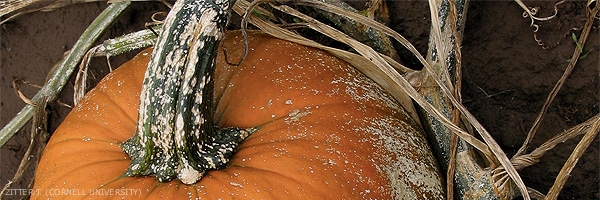
Monographella cucumerina (Lindf.) Arx, (1984)
Plectosporiose
- Classification: Fungi, Basidiomycota, Lichinomycetes, Hypocreomycetidae, Incertae_sedis_, Plectosphaerellaceae
- synonymie : Cephalosporium tabacinum J.F.H. Beyma (1933) ; Fusarium tabacinum (J.F.H. Beyma) W. Gams (1968) ; Microdochium tabacinum (J.F.H. Beyma) Arx (1984) ; Plectosporium tabacinum (J.F.H. Beyma) M.E. Palm, W. Gams & Nirenberg, (1995), Plectosphaerella cucumerina (Lindf.) W. Gams, Plectosphaerella cucumeris Kleb.
- English names: Plectosporium blight, Microdochium blight
This fungus, which is widely distributed throughout the world, has been reported on various Cucurbits in a more limited number of production areas located in the United States, Asia and Europe in particular.
It is able to attack plants belonging to various botanical families. On Cucurbitaceae, it affects: hubbard squash, buttercup, mammoth squash, pumpkin, yellow squash, zucchini and gourds (but also on butternut squash - Cucurbita moschata - and pumpkin - Cucurbita maxima ). It has also reported as a pathogen on tomato, basil, lupine, sunflower, peanut, sugar beet, bellflower. Note that it has been isolated in many soils in the world and on the roots of the most varied hosts.
In France, M. cucumerina does not seem to affect Cucurbitaceae. On the other hand, we have observed it fairly systematically and isolated it on the roots of tomatoes grown in soil, but especially in soilless. It is in this latter cultural context that it finds particularly favorable conditions for its development.
Note that M. cucumerina is also used as a bio-herbicide on certain weeds, in particular during the early stages of seedling development ( Galium spurium ). It is also considered to be a nematophagous fungus because it was isolated from egg masses of Meloidogyne hapla parasitizing tomato roots in Belgium.





